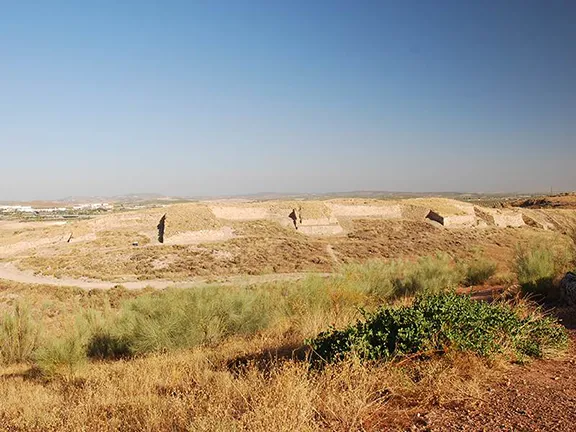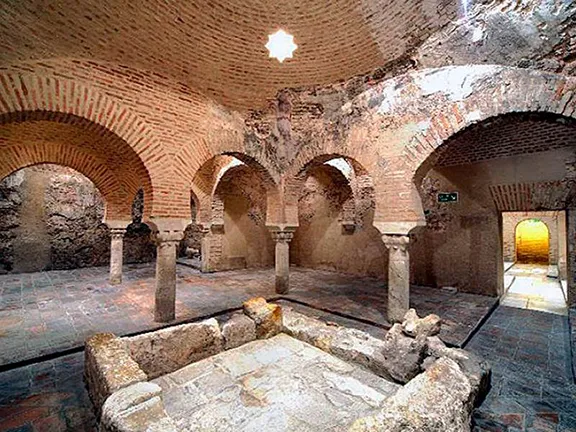Jaén is also known by historians as the “Holy Kingdom”. This is because almost the same area making up Jaén province today was once a kingdom, ruled first by the Muslims and then by the Christians.
By Nick Nutter | Updated 8 Sep 2022 | Jaén | Cities |
Login to add to YOUR Favourites or Read Later


Santa Catalina Gatehouse
Jaén can trace its origins back to the 7th century BC when the Iberians built an oppidum on an existing agricultural settlement at Puente Tablas, about 5 kilometres northeast of the present city. The Iberians abandoned their town during the 4th century and moved to another oppidum on the side of Santa Catalina Hill, the hill that dominates the Jaén skyline.


Puente Tablas - Iberian oppidum
The settlement on Santa Catalina Hill overlooked the fertile valley of the Rio Guadalquivir and was on an important trade route that gave access south to Granada and west to Seville and the Atlantic Ocean. Its strategic position, plus the fertile surroundings, enhanced by the important mineral deposits in the Sierra Morena, north of Jaén, made it a target for Carthaginian and Greek traders. General Hannibal Barca is said to have built a castle although there are no traces of it today.
About 207 BC, during the Second Punic War, the city was taken from the Carthaginians by the Roman general, Scipio Africanus. The Romans gave the city its first recorded name, Auringi. Although described by some chroniclers as an opulent and fertile city, Auringi remained a bit of a Roman backwater, only becoming a municipality in the 1st century AD with the name Flavio Aurgitano.
The Visigoths arrived as the Romans departed sometime around 530 AD but even the Visigoths tended to ignore the city that remained dominated by its Hispano-Roman occupants. The Visigothic treasure of Torredonjimeno, consisting of hundreds of fragments of gold objects and gems that came from several votive crowns and crosses, some of them belonging to an unidentified Visigothic king was found buried in an orchard some 12 kilometres west of the city.


Arab Baths Jaen
The Muslim occupation began in 711 AD and they immediately recognised the importance of Jayyan.
The city became the head of an important kura or kingdom in the emirate and caliphate period of Al-Andalus, a kura almost as large as the current province. During the Fitna of al-Andalus (a civil war), the kura was taken over and divided between the neighbouring kuras of Cordoba, Granada and Toledo. Jayyan was conquered by Habbus al-Muzaffar, leader of the Zirid Taifa of Granada. Decades after the final demise of the caliphate of Cordoba, Jayyan was conquered by the Almoravids in 1091.
The ownership of Jayyan was again in dispute some sixty years later when it was taken in 1159 by Ibn Mardanis (the Rey Lobo, ruler of Valencia who opposed the spread of the Almohad Empire), his father-in-law, Ibn Hamusk, surrendered and yielded Jayyan to the Almohads in 1169.
The Christians arrived at the gates to Jaén in 1225 AD when Ferdinand III of Castile laid siege to the city. Over 3,000 knights and 50,000 foot soldiers were unable to break through the city walls erected by the Almoravids. Ferdinand returned in 1230 and was similarly unsuccessful. The city only fell after the Nasrid sultan, Muhammad I of Granada, surrendered Jaén as part of a vassalage package.
Despite being, nominally, the capital city for the Kingdom of Jaén, the city was eclipsed by the towns of Baeza and Ubida, partially due to its continued dependence on agriculture whereas Baeza and Ubida developed a textile industry and attracted wealthy landowners who built magnificent Renaissance mansions.
French troops occupied Santa Catalina Castle in Jaén, from January 1810 until September 1812. The Napoleonic troops turned the fortified enclosure into a large barracks and installed accommodation for the regular troops, stables, dungeons, offices, powder rooms and even a hospital with fifty beds.
From 1820 until 1823, a liberal government ruled Spain following a military uprising by lieutenant-colonel Rafael de Riego against the absolutist rule of Ferdinand VII. A Provincial Council was formed in Jaén.
Jaén supported the Republican government during the war and was the capital of Republican Andalusia and the Army of the South. The city jail and Cathedral were pressed into use for prisoners loyal to the Nationalist cause. It was from Jaén that the so called ‘Death Trains’ departed for Madrid on the 11th and 12th August 1936 carrying hundreds of prisoners, including the Bishop of Jaén Manuel Basulto y Jiménez and his sister who were murdered in front of two thousand celebrating spectators by a special executioner, a woman nicknamed La Pecosa, ‘the freckled one’. In all, over 200 prisoners were machine gunned.
On 1 April 1937, six German Ju 52 bombers of the German Condor Legion, escorted by six Heinkel He 51 and three CR 32 fighters, bombed the city of Jaén in retaliation for a Republican air raid on Córdoba. 159 people were killed and 280 wounded.
Having supported the Republicans until 1939, the Franco years were not kind to Jaén and the city declined. It was not until the restoration of the monarchy in 1978 that Jaén began its economic development. Municipal, regional and national government, as well as European funds, reinforced the business network of the capital, promoted new public works, enlarged the city and made it a modern and entrepreneurial capital. In 1993 Jaén’s University was created.